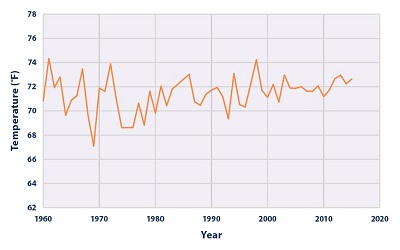|
|
| |
|
|
| |
|
|
| Trends in Stream Temperature in the Snake River |
|
| |
 Tribal Connection: Trends in Stream
Temperature in the Snake River Tribal Connection: Trends in Stream
Temperature in the Snake River
This feature tracks the summer water temperature of the
Snake River.
Climate change has challenged and will continue to challenge
some of the traditional ways of life that have sustained
indigenous peoples for thousands of years. In the Pacific
Northwest, warming river and stream temperatures will
threaten ecosystems and species, including salmon
populations. Salmon play a particularly important role in
the diet, culture, religion, and economy of Native Americans
in this region. |
|
Pacific Northwest Salmon
Salmon are sensitive to water temperature at many stages of
their lives. They spend much of their adult lives in the
ocean, then migrate inland to spawn. Salmon need cold water
to migrate and for their young to hatch and grow
successfully. Warmer water can negatively affect fish,
making it more difficult for them to swim upstream. It can
also make fish more susceptible to disease. River and stream
temperatures in the Pacific Northwest are influenced by many
factors, but are expected to rise as average air
temperatures increase (see the U.S. and Global Temperature
indicator).
The graph shows average August water temperatures at a site
in the Snake River, in eastern Washington near Nez Perce
tribal lands. Several species of salmon use the Snake River
to migrate and spawn. Between 1960 and 2015, water
temperature has increased by 1.4°F.
Technical Documentation
Download related technical information PDF |
|
 Figure
1. Average August Temperature in the Snake River,
1960–2015 Figure
1. Average August Temperature in the Snake River,
1960–2015
This graph shows average August water temperatures at a site
along the Snake River in eastern Washington.
Data source: USGS, 20167 |
|
|
|
|
EPA Page |
|
This is the
EPA page for this topic. To see if the Trump
administration has changed the EPA page, simply click the
link and compare the information with this page. If you
notice changes were made to the EPA page, please post a
comment. Thanks. |
|
|
|
|
|
|
|
|
|
|
|
|
Additional Climate Change Information |
Climate Change and Carbon Dioxide
(Beginner - Listening,
reading)
A video lesson to
help with your understanding of climate change
and carbon dioxide.
The English is
spoken at 75% of normal speed.
Great English listening and reading practice. |
Carbon Dioxide and Climate Change
(Beginner - Listening,
reading)
A video lesson to
help with your understanding of carbon dioxide
and climate change.
The English is
spoken at 75% of normal speed.
Great English listening and reading practice. |
Environmental Group Warns Earth's Health at Risk
(Beginner - Listening,
reading)
A video lesson to
help with your understanding of climate change.
The English is
spoken at 75% of normal speed.
Great English listening and reading practice.
A report by the World Wildlife Fund looked at thousands of animal populations
and found they have dropped significantly in 40 years. |
Sea Levels Rising at Fastest Rate in 3,000 years
(Beginner - Listening,
reading)
A video lesson to
help with your understanding of climate change.
The English is
spoken at 75% of normal speed.
Great English listening and reading practice.
A group of scientists say sea levels are rising at record rates. Another group
found that January temperatures in the Arctic reached a record high. |
Capturing CO2 Gas Is Not Easy
(Beginner - Listening,
reading)
A video lesson to
help with your understanding of climate change.
The English is
spoken at 75% of normal speed.
Great English listening and reading practice.
Most scientists agree that carbon-dioxide gas is partly to blame for climate
change: rising global temperatures. But capturing the CO2 gas released by power
stations is costly and difficult. |
Growth, Climate Change Threaten African Plants and
Animals
(Beginner - Listening,
reading)
A video lesson to
help with your understanding of climate change.
The English is
spoken at 75% of normal speed.
Great English listening and reading practice.
Researchers believe Africa may lose as much as 30 percent of its animal and
plant species by the end of this century. |
|
|
|
|
Search Fun Easy English |
|
|
|
|
|
|
|
|
|
|
|
|
|
|
|
About
Contact
Copyright
Resources
Site Map |